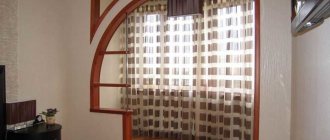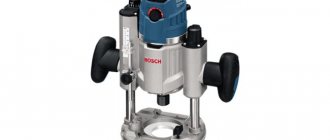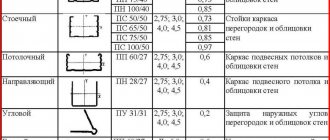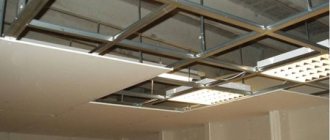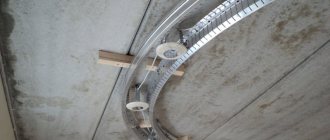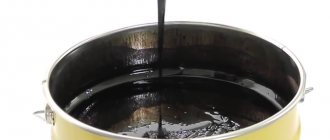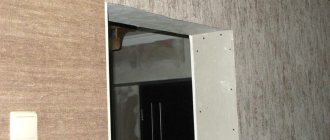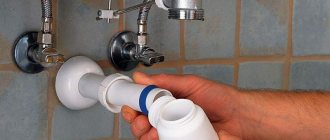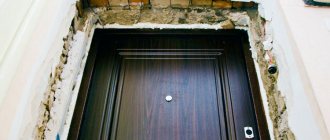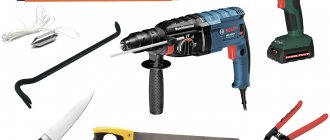Category: Door locks (3 ratings, average: 5,00 out of 5)
Published 08/01/2021 · Comments: · Reading time: 7 min · Views: Post Views: 15,258
The main task of a door lock is to prevent unauthorized access, so it must meet certain reliability criteria, which are established depending on the characteristics of the room or spaces. The internal structure of the locking mechanism is a basic nuance that should always be taken into account when selecting a lock.
In an era of intense technological progress, security systems are constantly being improved. Leading brands are constantly offering new means of protection, and they are usually based on classic mechanisms that are thoroughly redesigned.
When choosing a door lock, is the reliability of the device a priority criterion for you?
Not really
How to assemble a lock for a dacha, for a private apartment, house, office, so that it becomes an effective protection against an intruder - just choose the right model, taking into account the features of the internal structure and installation method.
How to choose a locking mechanism
The following protective devices can be inserted into the door leaf:
- cylinder;
- crossbar;
- electronic;
- level;
- code
Each device has certain pros and cons. A cylinder lock consists of small cylinders arranged in series within one mechanism. It is characterized by high reliability .
Cylinder lock
But this design is easy to drill out. To enhance the degree of protection, it is recommended to install armored linings. To protect against drilling, balls are provided in the design.
The mechanical cylinder protection kit has the following advantages:
- easy operation;
- quick replacement;
- easy repair;
- Possibility of installation on wooden and metal doors.
More often a deadbolt lock is installed. Since the design has a low degree of reliability, it is used simultaneously with an additional protection system. The impressive size is the main advantage of the deadbolt lock.
Crossbar system
A magnetic mechanism is often installed on entrance doors. This design is rarely hacked.
Magnetic system
Experts advise using a lever protection system. This universal option has a high degree of reliability. The narrow keyhole makes it difficult to break into. This mechanism is mounted on armored and wooden entrance doors.
Suval system.
An electromagnetic unit is considered an additional means of protecting a house or apartment from burglary. Installation of such a structure costs more than the lock itself. When choosing a door device, its reliability and financial capabilities are taken into account.
Required tools for installation
To secure the lock structure, it is not necessary to call a specialist. It is enough to determine the tools for independent operation.
A marker is required for all operations; chisel; drill with a diameter of 2.3 cm. (feather type); a simple pencil; screwdriver; screws, lock and handles included in the kit; stationery knife; construction tape; electric drill; wood cutter with a diameter of 5 cm. If you don’t have a marker, you can replace it with a simple pencil.
Basic and additional tools for manual installation
An additional, but no less important tool is a drill. For manual installation it is required. You can buy it in departments with door fittings (furniture, hypermarket, construction market). It’s better to take not just one, but a set of wood drills.
The drill bits must be wider than the locking device, so having a set you can select the required size. You will also need a hammer drill to level and enlarge the opening. A jigsaw is suitable for processing hard-to-reach parts.
Don't miss: How to remove and disassemble a round door handle: procedure
Markers are good at making markings on canvases, but they are absorbed and difficult to remove if you miss. The pencil will leave less marks, but a little will be visible on the surface. Use a pencil of medium hardness so that something too soft does not smear, and a hard one does not leave irreparable marks.
It is necessary to accurately take measurements and marks, not only so as not to leave unnecessary marks, but also to cut out all the parts evenly. If not cut correctly, the structure will jam or the locking mechanism will not be able to be inserted into the grooves.
For accurate measurements you need a tape measure, a building level and a caliper. A caliper allows you to measure the required position of decorative strips, grooves, and canopies.
A convenient length of a tape measure or metal ruler is 3m-5m. The metal ruler will not be damaged if it accidentally collides with other tools, so it will last longer.
A level is needed to install doors evenly and identify distortions that will affect long-term operation. For sawing trims and bars, it is better to use a miter saw. It does not split the edge like a jigsaw or hacksaw. A screwdriver may be needed to install handles, locks and awnings (to tighten hardware). After preparing all the tools, you can begin installation.
Selecting a router for self-assembly
Installing a lock on an interior door using a router is simpler and easier than using a drill. It speeds up the work, because you quickly get a neat hole. The milling cutter can be vertical (submersible), which can arbitrarily set the depth of the grooves. The device is very powerful and heavy.
Therefore, for working at home, it is better to use a special router, which has less weight and power. During installation, the tool for inserting locks should be convenient, then the work will come out neat. If the specialized framer is good, then the operation button allows you to control the degree of rotation, adding smoothness.
When selecting a device, the length of the cord, weight, location of control elements and functions are important. Before purchasing, be sure to turn on the machine and look at the movement of the head (it must be free). If there are distortions or play, the device will not be suitable for work.
For comfortable work, adjusting the rotation speed is important. A switch with a discrete rotation principle is good. The presence of protection on the switch will protect the device from dust, sawdust and mechanical damage. The cutter overhang indicator is also important. If it is larger, it will be difficult to drill the hole to the required mark.
Among the additional functions, the width of the surface view, minimal noise, backlight, various attachments, etc. are important.
Do you know how to work with a router?
Not really
Putting a lock on a wooden door
Installation of a mortise lock for a wooden entrance door is carried out at any height from the floor level, but usually 95-105 cm from the floor. The insertion process is carried out according to the following scheme:
Scheme of inserting a lock into a wooden door
- attaching the rear end of the device to the end of the web. Trace the outline with a pencil. The drawing should be in the center of the end;
- drilling holes;
- to level the walls of the groove, use a hammer and chisel;
- the lock is inserted into the hole;
- outlining the contour of the faceplate;
- timber cutting;
- marking the position of the larva;
- arrangement of the necessary holes;
- final insertion of the protective device followed by fixation;
- the structure is inserted into the cylinder;
- checking the functionality of the device;
- mechanism lubrication;
- fixing the bar.
An overhead security device can be installed on the door leaf . To do this, apply a locking template to the canvas. The holes for the cylinder and fasteners are marked. A through hole is drilled.
A cylinder with a ring is inserted from the outside. The plate is screwed from the inside. In this case, its edge should be flush with the end of the door leaf. Then it is recommended to release the valve and screw the device to the plate.
The position of the lock is marked on the jamb. A notch is made on the box. This will ensure that the plank is laid flush with the frame. If there are no distortions, the door closes easily. In this case, the plate is fixed on the jamb.
Interior models
If we consider the question of how the design of door locks works, we should definitely consider interior models. The design of a standard interior door lock can be divided into a separate category, since, unlike previous models, these products have a special design.
The circuit of such a door lock is combined with a handle. In this case, in addition to the latch, there is an outlet to the handle, which sets the halyard tongue in motion due to its connection with a rectangular cross-section rotary pin. Depending on the type of handle, such mechanisms are divided into three categories:
- rotary round;
- nobs;
- push.
Types of locks for interior doors
The design of an interior lock is almost completely identical to that of a mortise lock, but here the exit under the handle often has more space. It is impossible to make a high-quality lock on a door with your own hands without certain skills, but understanding their structure will be useful for every owner.
Putting a lock on a metal door
To install a mortise device into a metal sheet, it is necessary to prepare a hole for the handle and for the well. Then the position of the device is marked with a pencil and tape measure.
Use a drill to drill holes around the edges. A file is used to process the edges. The lock is installed in the canvas. The position of the fasteners is noted. Then the holes are drilled and the thread is cut.
You need to decide where the handle will be. The protective structure is applied to the canvas and marks are made. Holes are drilled. The functionality of the mechanism is checked. The handle is installed and the cover panel is screwed on. On the other side of the canvas, a hole is drilled for the crossbars.
We also recommend that you read the step-by-step instructions for installing a lock on a metal door.
Before installing an electronic lock on the front door, it is recommended to check its functionality. The universal design is controlled by a handle that opens the door from the inside.
The protection system consists of the following parts:
- lock;
- power supply;
- panel to enter the code;
- a fingerprint scanner or a mechanism that reads the card.
You can install a padlock on a metal sheet. To do this, it is applied to the door, marking for pins and fastenings. The mechanism in question is installed above its mortise counterpart.
Fastening pins are installed on the canvas. Taking into account the marks made, holes are drilled for the well to exit to the outer part of the canvas. The trim is secured to the pins from inside the house.
The next stage is checking the functionality of the protective device and then fixing the housing to the canvas. On the other side, an overlay is installed. To fix the crossbars, an overhead block is used. It is fixed on the other side to the box. To do this, a hole is made in the frame and a thread is cut.
The panel is fixed with screws. Some overhead mechanisms involve cutting recesses in the box. In this case, the box protrudes to the level of the lock itself.
Overhead structures
The design of a padlock can be called simpler. Today they are used less and less. A special feature of the overhead door lock is that, according to GOST, it is attached to the door leaf without additional recess. The system consists of two parts: the main part contains a cylinder and a latch on one side, the well goes out on the back side. The second part is the response panel where the crossbars go.
The mating part is also overhead, so if you do the installation yourself, it must be conveniently placed on the frame exactly opposite the exit of the pins.
Overhead lock model
How to change the larva
Replacing the cylinder cylinder mechanism begins with dismantling the lock itself. To do this, unscrew the screw located at the end of the structure. Then you need to press on the part, pulling the cylinder towards you.
The old larva is replaced by a new analogue. It must clearly match the parameters of the previous larva . A screw is used to secure the device. To fix the larva, the core is inserted into the nest. Then the lock is tested. The key should turn silently and smoothly.
The new lock cylinder must be similar to the old one
If you need to replace the cylinder in the cross-shaped mechanism, then it is recommended to install a new system. This is explained by the low reliability of this mechanism. A similar situation occurs when repairing a disk lock. Replacing the cylinder in the pin mechanism is carried out according to a similar scheme as in the cylinder lock.
To replace the larva in more complex mechanisms, the help of professionals will be required.
How to assemble a lever lock. We disassemble/assemble the lever lock with our own hands
The secret of a lever lock is much larger in size than the cylinder of a cylinder locking device. It is much easier to gain access to the elements of the secret, which means that such a lock can be completely assembled and disassembled without special tools. However, before dismantling the secret, check the diagram, because the position of the lever plates in different locks may differ.
To disassemble the lever lock, you need to prepare a screwdriver, suitable lubricant and a rag. First of all, we unscrew the fasteners holding the lock body cover. We remove the cover, thereby exposing the secret mechanism and other elements located in the case. We will be interested in a spring-loaded stack of metal plates with fancy cutouts, this is the secret of the lock.
We move the springs to the side and remove the stack of plates from the body. Please note that the plates are threaded on special fasteners and are in direct contact with the shank post. This makes reassembling the plates any other way a rather difficult task.
Having performed the necessary manipulations with the plates, we put the secret back together. The plates in the stack are arranged in a certain order; changing this order will lead to the recoding of the secret. This means you need to assemble the plates in the same sequence. We insert the plates one at a time into the fastening elements of the secret and spring them one by one. Once all the elements are installed, you can close and screw the lock housing cover.
Maintenance of the entrance lock
To care for the door device, a special lubricant is used, which can be of the following types:
- silicone;
- lithium;
- oil
Constant lubrication of the lock will ensure long-term operation of the mechanism.
Each composition is characterized by certain valuable properties. If the lock is constantly lubricated, then it will function without problems. At the same time, it is recommended to lubricate the hinges. To increase the service life of the lock, it is recommended not to apply force to the cylinder itself during its installation, when turning or inserting the key.
You cannot insert 2 keys on both sides of the door at the same time. It is also not recommended to insert various objects into the cylinder. It is forbidden to turn the inserted key if it has not reached the stop. If the device jams, it is recommended to clean it from dirt and dust.
Door lock device with handle. Lock mechanism
So, what does an entrance door lock consist of? The main part is the larva, it is the very mechanism that ensures the blocking of the structure in the opening and prevents strangers from entering the room.
The following models are distinguished:
- cylinder;
- levelers;
- disk;
- crossbars;
- crusades.
Door lock options depending on the locking mechanism
Cylinder. These are the most common products, the secret part of which is located in a part similar to a cylinder. The structure of the so-called English lock is as follows: inside the cylinder there are pins that lock the mechanism in the closed position. The key has notches that move these pins according to the diagram and allow you to turn the mechanism.
Level ones. These products are very reliable. The design of a lever door lock involves the presence of levers inside the mechanism. The key has the shape of a so-called butterfly or soldier and, when turned, raises them to the level specified by the coding.
Disk. This is not the most reliable option, but it can still be used. The key looks like a rod cut in half with several notches. Inside the lock, this key turns the discs, forming a tunnel and releasing the mechanism.
Crossbars. The device of such a door lock is equipped with a latch on the reverse side. Today, such options are rarely used due to their unreliability. The essence of the device is the presence of two crossbars, which are pulled back with a special key or latch.
Crusaders. The weakest type, the key has a cross shape. The larva can be opened with a Phillips screwdriver or any other suitable object.
Practical recommendations
- Initially, focusing on the lever lock as the most complex, it is better to buy one of the imported products. Their repair is somewhat simpler, since almost all the parts necessary for replacement can be purchased at retail. In addition, it is possible to “reconfigure” the levers. But most domestic samples cannot be recoded.
- In order to be less likely to encounter the problem of how to change a door lock, it needs to be lubricated periodically. Moreover, it is not necessary to dismantle and disassemble the mechanism. A syringe is enough, the needle of which fits freely into the well. After injecting engine oil, you only need to turn the key to the sides a few times, to the limit.
